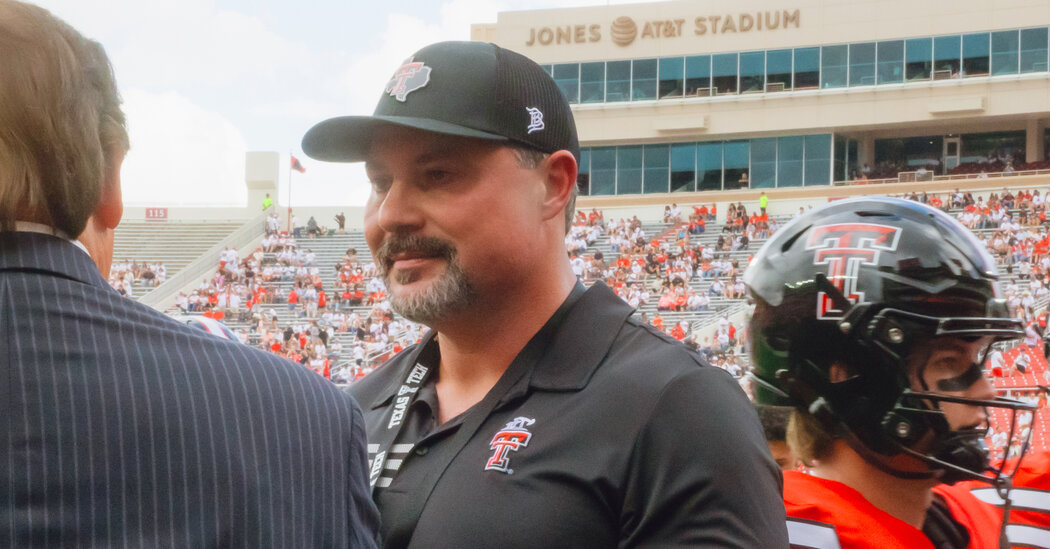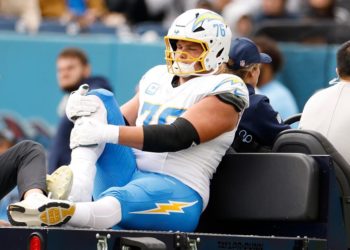On game day, at Texas Tech University, Cody Campbell is treated like royalty. He enters the football stadium with his children at his side to hear the pregame pep talk. He shakes hands with baby-faced recruits and poses for a photo with an admirer, flashing the “guns up” hand gesture unique to the school.
Mr. Campbell, who made his fortune in oil, has helped make the Texas Tech Red Raiders one of the top college football teams in the country. He has helped to fund the team’s $25 million payroll and pay for its new 300,000-square-foot training center, which anchors the south end zone.
But amid all this good will and glory, Mr. Campbell knows deep down that college sports are in serious trouble. And now he’s now fighting to save them, in many ways, from billionaires like himself.
Twenty-five years ago, when Mr. Campbell played football for Texas Tech, student-athletes could not accept a free meal or a pair of shoes. Now, in the name, image and likeness (N.I.L.) era, student-athletes can earn millions a year, which mostly comes from donors like Mr. Campbell.
But a vast majority of donations are going to football and basketball programs, where pressure to pay for the best players in order to field the most competitive team is intense.
The means schools without deep-pocketed alumni have to dip into academic funds, increase student fees or drop non-marquee sports to keep funding their football and basketball programs.
It is creating a troubling irony for colleges: At a time when money has never flowed more freely into the pockets of high-profile college athletes, many collegiate sports programs are struggling for resources.
Since July, Mr. Campbell said, 182 sports programs have been cut for budget reasons, many of them women’s sports and less high-profile sports such as track, swimming and wrestling. That’s a tiny faction of the 19,000 teams in the National Collegiate Athletic Association, but Mr. Campbell worries it is only the start of the cuts.
Hoping to reverse this trend. Mr. Campbell has founded a nonprofit, Saving College Sports, to protect those sports from being axed and depriving student-athletes of playing a college sport like he did.
He has one high-profile supporter: President Trump, who named Mr. Campbell to the President’s Council on Sports, Fitness and Nutrition, a federal advisory committee, and granted him special government employee status to come up with solutions for a college sports industry increasingly difficult to fund. In July, the president issued an executive order, titled “Saving College Sports,” that echoed Mr. Campbell’s mission to protect all student-athletes.
Mr. Campbell’s first target is to modernize the Sports Broadcasting Act, which was written in 1961, to allow colleges to pool their media rights as the National Football League and other professional leagues do.
The way the system currently works is that powerhouse conferences — the Big Ten, the Southeastern Conference, the Big 12 and the Atlantic Coast Conference — each sell the rights to their games to various television networks then divided up among their schools. But the television money often ends up going to the football and basketball programs and not spread among lower-profile sports.
If those so-called Power 4 conferences pooled their media rights, Mr. Campbell said, they could then find networks willing to pay to broadcast football games but offer networks and streaming platforms packages in less-watched sports like volleyball and field hockey. This arrangement could spread media revenue across a school’s sport teams.
Operating from one large pool, the conferences could control the rights to all of their sports. They could control the schedule of game times so attractive matchups between top teams are not competing against one another on different networks. It offers an opportunity to elevate sports that are popular but have not been promoted, like women’s volleyball, softball, wrestling and diving.
“Give the colleges more leverage in their negotiations so it’s not just the conferences competing with each other for these different deals,” Mr. Campbell said.
Mr. Campbell has met fierce resistance, however, from N.C.A.A. and television network executives, and especially conference commissioners, all of whom have long been the gatekeepers of the multibillion-dollar college sports complex.
“The conferences are all represented by commissioners who are very, very self-interested,” Mr. Campbell said.
When he said as much in a television ad that he paid for, ABC and Fox refused to air it. Both have media contracts with the Power 4 conferences.
Mr. Campbell knows much about return on investments and sustainability. He has built and sold $15 billion in businesses, most of them related to oil. Growing up in Canyon, Texas, he was destined to become a Red Raider. He is a fourth-generation Tech alumnus. His father played football, and one of his great-grandfathers was part of Tech’s first entering class in 1925.
He arrived on campus in 2000 as not only a highly accomplished football player but also a National Merit Scholar. He played on the offensive line and earned a bachelor’s degree in economics and finance as well as a master’s in business administration. His wife, Tara, is also a Texas Tech alum.
“I feel like college athletics are a pillar of American culture, part of our communities,” Mr. Campbell said. “I want to make sure that it is preserved.”
In recent months, wealthy alumni like Mr. Campbell have given staggering amounts to their athletic departments.
-
At the University of Kansas, David Booth, a financier, donated $300 million, thought to be the largest single gift directed to college sports.
-
At Stanford, Bradford M. Freeman gave $50 million of his private equity fortune to be used on football alone.
-
Oracle’s co-founder Larry Ellison, along with Dave Portnoy of Barstool Sports, used a more than $10 million offer to woo quarterback Bryce Underwood, the nation’s top prospect, to the University of Michigan, where he is the starting quarterback.
Since 2022, Mr. Campbell and his fellow Matadors, a collective he helped found, have raised $63 million for sports at Texas Tech.
Among the alumni are oilmen and entrepreneurs who valued their time at Texas Tech, Mr. Campbell said, and no longer “want to play little brother” to the University of Texas and Texas A&M.
They also knew the sun was setting on the anything-goes phase of the athlete acquisitions when the House v. N.C.A.A. antitrust lawsuit settlement went into effect over the summer. The settlement essentially limits the amount that schools can pay athletes across all sports each year to $20.5 million.
Many schools do not even come close to spending that amount, but it will mean a big adjustment at Texas Tech. Mr. Campbell and his collective spent $55 million paying Texas Tech athletes for this school year alone.
“We saw a window where the House settlement was coming, but N.I.L. in its Wild West form still existed,” Mr. Campbell said.
And so far this year’s investment is paying off: The Red Raiders (8-1) are ranked No. 9 in the nation.
For Johncarlos Miller II, a tight end, the money from Mr. Campbell’s collective was life changing, but having Mr. Campbell as a mentor was a much-appreciated bonus. Mr. Miller transferred from Elon University in North Carolina two years ago for what he said was “significant money.” The nondisclosure agreement he signed prevented him for being more specific.
Mr. Miller manages his own portfolio of stocks and bonds and bought land near his hometown, Greensboro, N.C., that he intends to turn into an R.V. park.
“I ask him about business, and we text each other,” Mr. Miller, who is a sport management major, said of Mr. Campbell. “He is definitely present in our program.”
In the era before N.I.L., paying players was prohibited, but many programs paid their student-athletes under the table.
“Those were nickels and dimes,” Mr. Campbell said. “Now, we’re talking real money, and there needs to be a system in place to sustain the market.”
Mr. Campbell envisions an organization like the United States Olympic & Paralympic Committee to replace the N.C.A.A. and make student-athletes “partners not pawns.”
Greg Sankey, the commissioner of the Southeastern Conference, said the oilman had a “fundamental misunderstanding” of the realities of college sports. The SEC recently signed a 10-year TV deal with ESPN worth a reported $3 billion.
The Big Ten is in the middle of a media rights deal worth more than $7 billion that runs through the 2029-30 school year and has no interest in bundling its media rights with anyone.
The N.C.A.A. also is opposed.
“When you start talking about the Sports Broadcasting Act in such a short time frame with some federal authority overseeing it, oh, boy, that feels to me like the kind of thing that needs a lot more work,” Charlie Baker, its president, said.
In the meantime, Mr. Campbell and his fellow Matadors continue to raise money to help prevent his alma mater from cutting sports, using funds earmarked for academic pursuit or adding student fees.
“We are the haves, not the have-nots,” he said. “We aren’t going anywhere.”
Ken Belson contributed reporting.
Joe Drape is a Times reporter writing about how the intersection of money, power and sports impacts our culture.
The post Meet the Billionaire Trying to Save College Football From Itself appeared first on New York Times.




